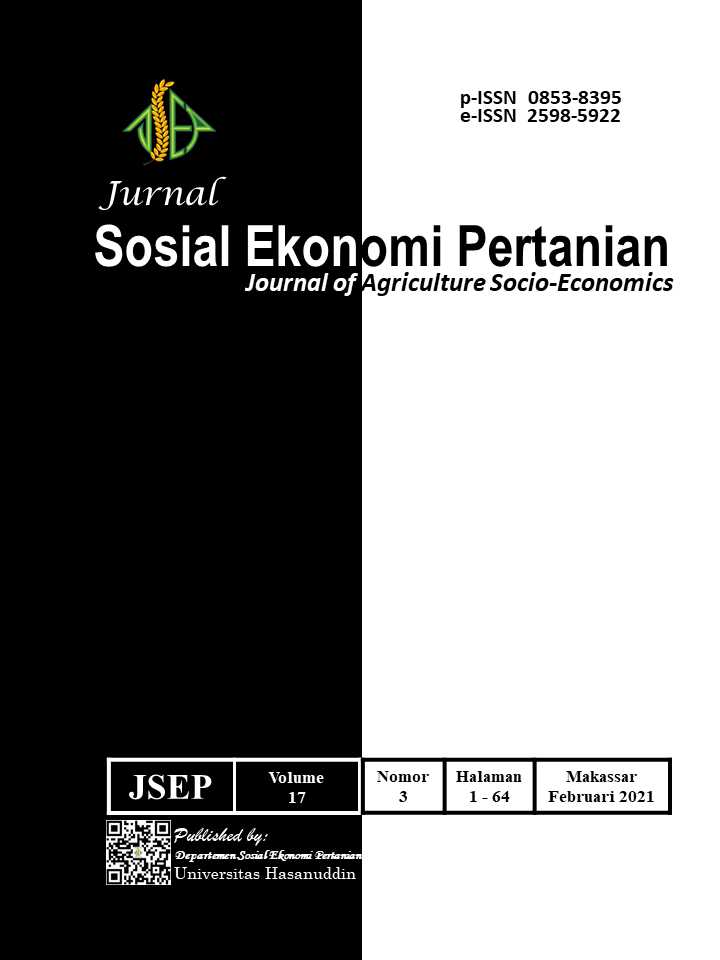Internal and External Factors Determining Welfare of Jambu Mete Farmers in Mata Kapore Village, Sumba Barat Daya District
Main Article Content
Abstract
Downloads
Article Details

This work is licensed under a Creative Commons Attribution-NonCommercial 4.0 International License.
This works is under Creative Commons Attribution LicenseReferences
Fauziyah, E., Aniyatussholihah, & Hidayati, D. R. (2017). Strategy of Export Competitiveness Enhancement on Cashew Nut Commodity. JEJAK Journal of Economics and Policy, 10(2), 302–316. https://doi.org/http://dx.doi.org/10.15294/ jejak.v10i2.11295.
Guledgudda, S. S., Patil, B. L., & Rajur, B. C. (2014). Export performance of Indian cashewnut – An analysis. Economic Affairs, 59(4), 669–674. https://doi.org/10.5958/ 0976-4666.2014.00041.2
Hakim, N. (2018). Jurnal mega aktiva. Jurnal Mega Aktiva, 7 (April), 1–10.
Hartati, G. A. R., Budhi, M. K. S., & Yuliarmi, N. N. (2017). Analisis faktor-faktor yang mempengaruhi kesejahteraan petani di Kota Denpasar. E-Jurnal Ekonomi Dan Bisnis, 6(4), 1513–1546.
Indrawanto, C. (2004). Peningkatan Daya Saing Industri Mente Indonesia Melalui Pembentukan Klaster Industri Mente. Perspektif, 3(1), 15–23.
Kurniawan, B. P. Y. (2016). Strategi dan Prospek Pengembangan Jambu Mete (Anacardium occidentale. L) Kabupaten Jember. Jurnal Manajemen Teori dan Terapan, 9(3), 242–258
Pudjiastuti, A. Q. (2014). Perubahan Neraca Perdagangan Indonesia Sebagai Akibat Penghapusan Tarif Impor Gula. Agriekonomika, 3(2), 106–116.
Pudjiastuti, A. Q., Anindita, R., Hanani, N., & Kaluge, D. (2013). Effects of Sugar Price Increase in Indonesia. Oeconomica, 58(1), 28–39. https://doi.org/http:// studiaoeconomica.ubbcluj.ro/volumes.html
Pudjiastuti, A. Q., & Kembauw, E. (2018). Sugar Price Policy and Indonesia’s Trade Balance. Journal of Advanced Research in Law and Economics, 8(8). https://doi.org/10.14505/jarle.v8.8(30).26
Zahir, N., & Sanawiri, B. (2018). Analisis Daya Saing Kacang Mete Indonesia di Pasar Internasional ( Studi tentang Kacang Mete Indonesia Tahun 2011-2015 ). Jurnal Administrasi Bisnis (JAB), 54(1), 66–73.
Yusria, W. O. (2010). Keadaan Ekonomi Rumahtangga Petani Jambu Mete Di Kabupaten Buton Sulawesi Tenggara. Jurnal AGRISEP, 9(2), 109–119. https://doi.org/10.31186/jagrisep.9.2.109-119





